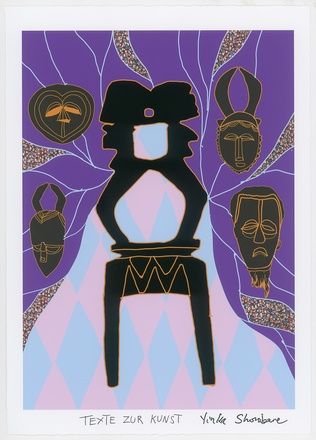Yinka Shonibare
Modernist Inspirations (2022)
In his multimedia practice, the British-Nigerian artist Yinka Shonibare deals with (post)colonialism in the context of globalization. He explores concepts of class and race, as well as the construction of cultural identity, focusing on interrelations between Africa and Europe in particular. For TEXTE ZUR KUNST, Shonibare produced a giclée print entitled “Modernist Inspirations,” referencing his current interest in the influence of African artifacts on Modernism around the 1920s and, more specifically, his own “Modern Magic VII” (2022), a work recently shown in his solo exhibition “Restitution of the Mind and Soul” at Goodman Gallery in Cape Town. The colorful forms on handmade paper and the sculptural application techniques allude to Dutch wax prints, the distinctively patterned cotton fabrics first produced in the Netherlands but often associated with West Africa. The central figure in “Modernist Inspirations” has been given a screenprint glaze; its shimmering quality enters into a dialogue with the work’s other forms and surfaces. The glossy section of the piece also lends structure to the coarse fibers of the paper. The edition’s preliminary drawing was created as part of Shonibare’s broader research into the ways in which Western modernist artists appropriated forms from African artifacts. The objects represented here cite items that once formed part of the collections of Pablo Picasso and Tristan Tzara. In this way, “Modernist Inspirations” is also an indirect quotation of both those artists’ work, whose concise formal language has been repeatedly reinterpreted in Shonibare’s practice.

